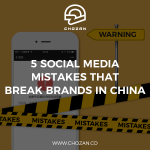There’s a stereotype of men in China when it comes to grooming, especially middle-aged men. And it’s not flattering. Fat, bald and wearing a white undershirt pulled up to showcase a tummy that an expectant mother would be proud of. Not the stuff of beauty marketing dreams.
As a result, for some time, they’ve been excluded from mainstream marketing images and narratives.
There’s even a joke that people spend more on fashion and grooming for their pets than older men spend on it for themselves.
There’s a lot of talk in China about the Sheconomy. Is there a male fashion and grooming heconomy? Equality in the realm of grooming and fashion consumption seemed impossible before but is it still the case now?
Data from a 2018 fashion white paper shows that in 2018, 3.5% of male consumers purchased the most expensive fashion items costing more than 50,000 yuan, 4.1% spent between 30,000 to 50,000 yuan, 11.3% spent between 10,000 and 30,000 yuan and 16% spent 5,000 to 10,000 yuan.
The average spending level was actually higher than for female consumers. On top of this, according to Questmobile, around 87 million men in China spend more than 1,000 yuan per month online.
The growth rate for sales of men’s skin care and grooming products in China was due to reach 13.5% from 2016 to 2019. This is much higher than the global average of 5.8%. The demand is mainly in Tier 1 and 2 cities where men with the strongest purchasing power for these products live.
How are the major players in male fashion and grooming performing?
For luxury brands, according to data from the 2018 Post-95s Fashion Consumer Report, the top 3 luxury product categories for men are watches, bags and accessories and JD.com reports that the top 5 popular luxury brands for Chinese men are Mont Blanc, Tumi, Coach, Versace and Gucci.
For local fashion brands, the most popular ones for men are Seven Wolves (七匹狼), Peacebird (太平鸟), HLA (海澜之家) and GXG.
How are these brands reaching male customers online and offline and what are their best practices?
Seven Wolves, uses JD Cloud Store’s WeChat mini program. JD Cloud Store, called JD Yunxiaodian (京东云小店) in Chinese, is JD’s social commerce platform with live streaming and group buying functions. Users can open stores or buy goods easily via mobile. Users can also send products link to others to upgrade their membership and receive store coupons.
By making full use of JD’s e-commerce power and WeChat’s social media power, Seven Wolves successfully established itself in the Tier 3 and 4 city market.
Uniqlo has fully integrated its online and offline stores. The slogan for its app is “One click to get anything you want”. On the app, you can see every item of clothing that they have in stock in China, including sizes and colours. Items can be purchased with options to pick them up in offline stores or have them delivered to your home.
Items can also be bought with a click on the brand’s official website and through its WeChat mini program. It has fitting rooms that use augmented reality (AR) available in 600+ offline stores all around China, which improves the online user experience by making trying on clothes more fun and can also make it easier to get the right fit while shopping online.
Jinyi Box (锦衣盒) is a clothing subscription box brand for men. Users pay 99 RMB for a lifetime membership and enjoy unlimited outfit recommendations. Each box has 3 outfits and a letter detailing each piece and its price. After trying them on, they can keep their favorite clothes and pay for them. The rest can be returned free of charge.
The challenges and opportunities ahead
An aesthetic consciousness is gradually awakening in China’s men and the boundaries of consumption are expanding. In addition to sportswear, automobiles, electronics and the usual products associated with men, they’re expanding their tastes and purchases in fashion, grooming, entertainment and more. The heconomy is here and growing.
However, challenges exist. There’s a strong contrast between the invisibility of men in terms of highly targeted events and campaigns, aside from Fathers’ Day. Internet culture and e-commerce in China still focuses more on women with events like JD’s Butterfly Festival and Tmall’s Queen’s Day. They clearly recognize women’s consumption power but may be doing it while ignoring opportunities in this product category for men.
At the same time, men face a lot of pressure. For example, in terms of hair loss, many people still joke about it but for people experiencing it themselves, it can be distressing. It’s also not talked about much in a serious, informative way. This can lead to self-consciousness, denial or silence on social media and might also lead to fewer purchases of these products or more purchases of low quality products and services as people aren’t as willing to share their personal experiences with them.
There’s also a feeling among some that men’s consumption is more about practical needs and that they are less likely to make impulse purchases. This means that many brands take a sort of “unmarketing” approach that focuses specifically on the product itself rather than the men and doesn’t try to appeal to them personally or on an emotional level. It’s also felt that men are less likely to seek friendships through social e-commerce, particularly in the area of grooming. They think this is why there’s never been a site specifically for men’s fashion and grooming products that’s been as successful as Xiaohongshu.
To get deeper insights into Chinese social media marketing and utilizing it to serve your business, join ChoZan, a training and resources platform for Chinese social media marketers.
Please follow our official WeChat account to get more updates about the latest news, feature updates and case studies.

Share this article on your favourite social media






